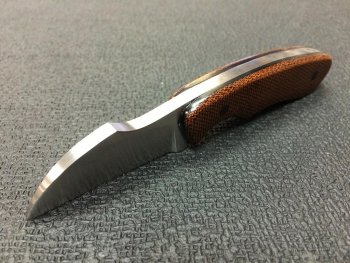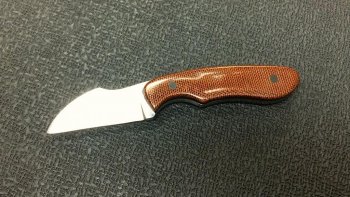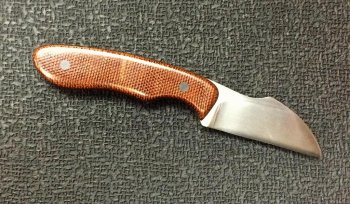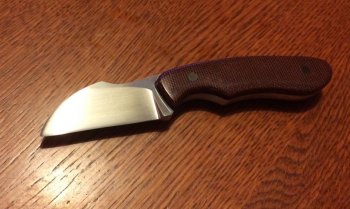DBAR
Well-Known Member
You CAN teach an old Dog new tricks....
I've always collected knives, and then one day it hit me, why not make my own? I started following some really good knife makers around the forums, and on Insta Gram, and I've slowly learned a lot. I followed the likes of Shawn Hatcher, Dmitriy of DP Custom Knives, John Doyle, and Denis Mura to mention just a few. I hope to be half as good as these guys some day. They all do some spectacular work! Shawn Hatcher has even answered some of my most basic question through emails, and I really thought that was pretty awesome for a pro like him to take the time to help out a newb like me. Thank you Shawn, and I want to thank all of the knife makers who take the time to share their work here with us, it means a lot to the little guys like me.
So here's my first learning experience. I've profiled, and rough ground bevels, and heat treated 10 knives so far. Some of which I have some pretty high expectations, but I knew this was going to take some trial and error, so I took a small piece of O1 scrap, and made a Wharincliffe version of one of my favorite little knives. A Bark River PSK, by Mike Stewart, another knife maker whom I follow quite a bit. In fact I've owned 20 of his knives at one time or another. I like convex, and convex saber grinds, and Mike tends to make a lot of those.
This is a little knife, only 5 1/8" long, with a convex blade of only 2". I worked with O1 tool steel, and had the joy of learning how to heat treat and temper it myself. I finished this knife off with a hand sanded finish up to 600 grit. The scales are made of natural canvas micarta, with black G10 liners & black carbon fiber pins. My plan was to do an Anso texture, but for know it's just a polished finish. I may still do the Anso (I'd be learning how to do both handle techniques). I'll be finishing up the shaped convex edge tomorrow. I know this knife isn't perfect, it has imperfections, but I believe it's a good start, and someday I will produce one that's near perfect.



Sorry about the poor pictures. I'm having a hard time shooting a picture of the finish on the blade.
Maybe this one's better.

In making this knife I tried to use different techniques before ending up with one result, I wanted to learn as much as I could on one work. This was a very good learning experience.
Thank You,
Don
I've always collected knives, and then one day it hit me, why not make my own? I started following some really good knife makers around the forums, and on Insta Gram, and I've slowly learned a lot. I followed the likes of Shawn Hatcher, Dmitriy of DP Custom Knives, John Doyle, and Denis Mura to mention just a few. I hope to be half as good as these guys some day. They all do some spectacular work! Shawn Hatcher has even answered some of my most basic question through emails, and I really thought that was pretty awesome for a pro like him to take the time to help out a newb like me. Thank you Shawn, and I want to thank all of the knife makers who take the time to share their work here with us, it means a lot to the little guys like me.
So here's my first learning experience. I've profiled, and rough ground bevels, and heat treated 10 knives so far. Some of which I have some pretty high expectations, but I knew this was going to take some trial and error, so I took a small piece of O1 scrap, and made a Wharincliffe version of one of my favorite little knives. A Bark River PSK, by Mike Stewart, another knife maker whom I follow quite a bit. In fact I've owned 20 of his knives at one time or another. I like convex, and convex saber grinds, and Mike tends to make a lot of those.
This is a little knife, only 5 1/8" long, with a convex blade of only 2". I worked with O1 tool steel, and had the joy of learning how to heat treat and temper it myself. I finished this knife off with a hand sanded finish up to 600 grit. The scales are made of natural canvas micarta, with black G10 liners & black carbon fiber pins. My plan was to do an Anso texture, but for know it's just a polished finish. I may still do the Anso (I'd be learning how to do both handle techniques). I'll be finishing up the shaped convex edge tomorrow. I know this knife isn't perfect, it has imperfections, but I believe it's a good start, and someday I will produce one that's near perfect.



Sorry about the poor pictures. I'm having a hard time shooting a picture of the finish on the blade.
Maybe this one's better.

In making this knife I tried to use different techniques before ending up with one result, I wanted to learn as much as I could on one work. This was a very good learning experience.
Thank You,
Don
Last edited:

